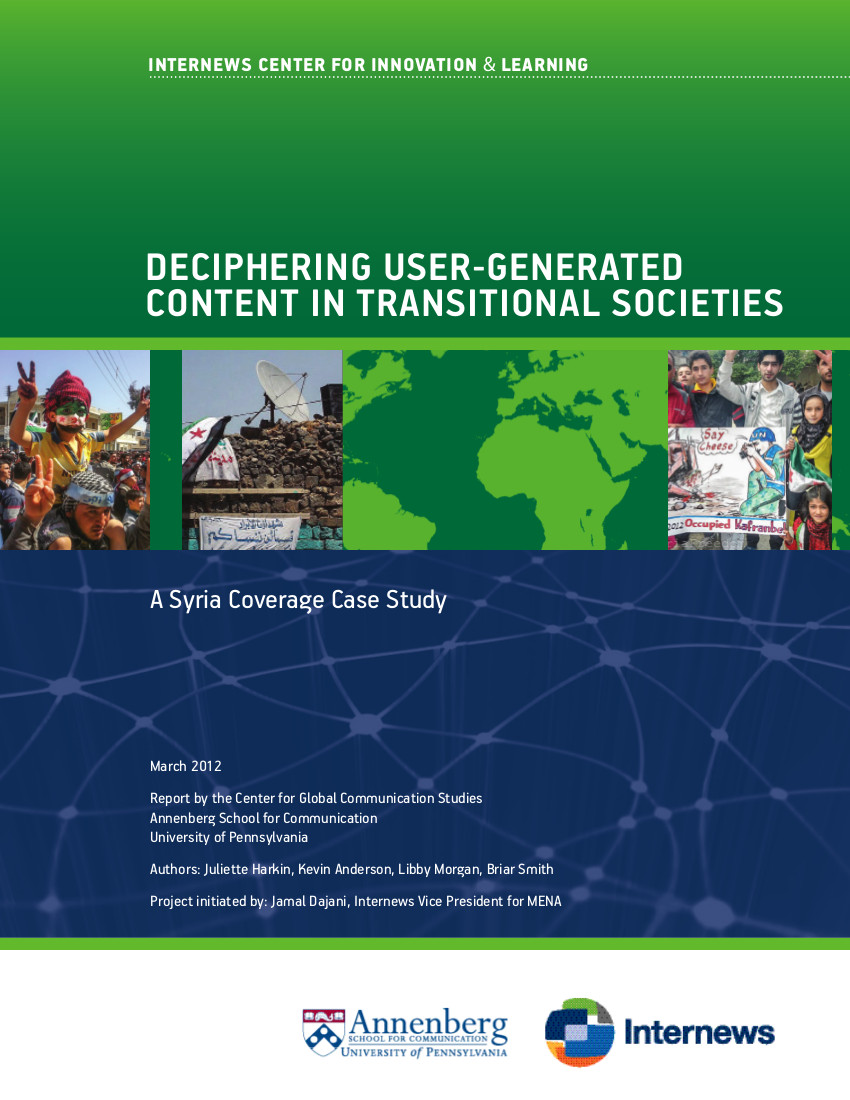Deciphering User-Generated Content in Transitional Societies: A Syria Coverage Case Study (2012)
Filed under report | Tags: · activism, journalism, mass media, social media, syria

“Social media and user-generated content played an important role in coverage of the revolutions in Egypt, Tunisia and Libya; however, content from the public was supplementary to traditional newsgathering in media coverage.
By contrast, in Syria, with the tight control and exclusion of foreign media, news organizations had to rely almost exclusively on user-generated content, particularly in the early months of the uprising. Much of the user-generated content used by news outlets came via Syrian activists inside Syria and in exile.
To examine how user-generated content has been integrated into prominent Arab-language news organizations, Internews commissioned and collaborated with the Center for Global Communication Studies to produce Deciphering User-Generated Content In Transitional Societies: A Syria Coverage Case Study which looks closely at how BBC Arabic and Al Jazeera Arabic used social media, photos and videos taken by members of the public to provide coverage of the uprising in Syria, particularly in the early days of the uprising.
Based on research conducted over a 12-week period between November 2011 and January 2012, this study employed a qualitative, mixed method approach using literature review, in-depth interviews with 19 media practitioners, academics, activists and commentators; and, a content analysis of the news and current affairs output of BBC Arabic and Al Jazeera Arabic, focusing on three major events at different stages of the Syrian revolt.”
March 2012
Report by the Center for Global Communication Studies, Annenberg School for Communication, University of Pennsylvania, commissioned by Internews
Authors: Juliette Harkin, Kevin Anderson, Libby Morgan, Briar Smith
40 pages
Digital Forensics and Born-Digital Content in Cultural Heritage Collections (2010)
Filed under report | Tags: · archive, cultural heritage, digital forensics, forensics, library, preservation

“While the purview of digital forensics was once specialized to fields of law enforcement, computer security, and national defense, the increasing ubiquity of computers and electronic devices means that digital forensics is now used in a wide variety of cases and circumstances. Most records today are born digital, and libraries and other collecting institutions increasingly receive computer storage media as part of their acquisition of “papers” from writers, scholars, scientists, musicians, and public figures. This poses new challenges to librarians, archivists, and curators—challenges related to accessing and preserving legacy formats, recovering data, ensuring authenticity, and maintaining trust. The methods and tools developed by forensics experts represent a novel approach to these demands. For example, the same forensics software that indexes a criminal suspect’s hard drive allows the archivist to prepare a comprehensive manifest of the electronic files a donor has turned over for accession.
This report introduces the field of digital forensics in the cultural heritage sector and explores some points of convergence between the interests of those charged with collecting and maintaining born-digital cultural heritage materials and those charged with collecting and maintaining legal evidence.”
Written by Matthew G. Kirschenbaum, Richard Ovenden, Gabriela Redwine, with research assistance from Rachel Donahue
Publisher Council on Library and Information Resources, pub149, December 2010
ISBN 9781932326376
93 pages
PDF, PDF (updated on 2018-12-6)
Comment (0)#Intelligence (2012)
Filed under report | Tags: · intelligence agency, privacy, social media, surveillance

The growth of social media poses a dilemma for security and law enforcement agencies. On the one hand, social media could provide a new form of intelligence – SOCMINT – that could contribute decisively to keeping the public safe. On the other, national security is dependent on public understanding and support for the measures being taken to keep us safe.
Social media challenges current conceptions about privacy, consent and personal data, and new forms of technology allow for more invisible and widespread intrusive surveillance than ever before. Furthermore, analysis of social media for intelligence purposes does not fit easily into the policy and legal frameworks that guarantee that such activity is proportionate, necessary and accountable.
This paper is the first effort to examine the ethical, legal and operational challenges involved in using social media for intelligence and insight purposes. It argues that social media should become a permanent part of the intelligence framework but that it must be based on a publicly argued, legal footing, with clarity and transparency over use, storage, purpose, regulation and accountability. #Intelligence lays out six ethical principles that can help government agencies approach these challenges and argues for major changes to the current regulatory and legal framework in the long-term, including a review of the current Regulation of Investigatory Powers Act 2000.
Authors Sir David Omand, Jamie Bartlett, Carl Miller
Publisher Demos, London, 24 April 2012
ISBN 978-1-909037-08-3
Creative Commons license
106 pages

